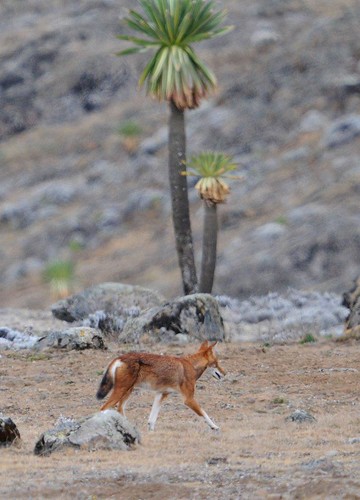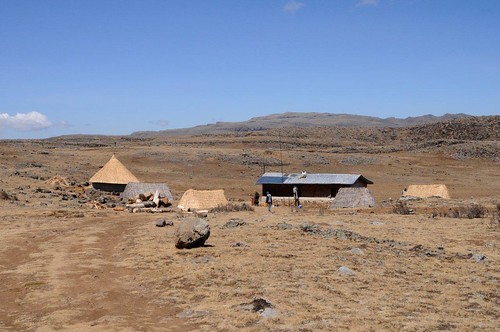One of my mystery bird photographers, Dan Logen, just returned from Ethiopia, and tells us a story about his time spent with the endangered Ethiopian wolf
The eight of us sat on a rocky perch at 4096 meters (13,438 feet) elevation, snacking on our picnic lunch and observing the rarest canid in the world. That we all arrived safely at this point was somewhat surprising, as we had just hiked several kilometers up and down mountainsides at this elevation, and were a motley crew of ecotourists; some of us old, some of us overweight, and others with various health problems. We were in the Bale (rhymes with "valley") Mountains National Park in Ethiopia, watching the Ethiopian wolf, Canis simensis.
The Ethiopian wolf lives nowhere else in the world. It has just seven populations in Ethiopia and numbers only about 500 individuals in total. It lives at high elevations -- above 3200 meters -- in the Afro-alpine zone. Its diet consists almost exclusively of the diurnal giant mole rat, Tachyoryctes macrocephalus. Unlike most wolves, the Ethiopian wolf is usually a solitary hunter, pouncing on the rats when they come out of their burrows, or digging them out. Occasionally the wolves may hunt as a pack, and bring down a hare, hyrax, or young ungulate. Although they typically hunt alone, they are otherwise very social animals, living in packs consisting of 8-25 animals, depending on the number of young. Each pack maintains a specific territory, although females will leave their natal pack to join another, and wandering males account for the majority of breedings.
By far, the largest population of Ethiopian wolves occur in the Bale Mountains, and seeing some of them was our primary goal in visiting this mountain park. We had spent several hours driving the roads searching for the wolves with no success. A side road then led us to a small camp consisting of two building and a few simple shelters for tents, elevation 4132 meters (13,556 feet). A grizzled, bearded, partially toothless man named Tahir greeted us, in Amharic, I presume. He was wearing a traditional Muslim headdress, as well as a Pentax binocular around his neck -- a good sign, I thought. He seemed ageless; perhaps he was a weathered young man, or maybe he was a well-preserved old man.
Solomon, our guide, told us that Tahir was a park ranger of sorts, and his responsibility was to protect the Ethiopian wolf. Even better, Tahir had agreed to lead us to a wolf den, if we were willing to walk just over the hill behind the camp. Something was lost in translation, as the expected short and easy walk turned out to be an arduous hike over several hills. I'm sure the high altitude and the accompanying hypoxia distorted our estimates of the distance, but it seemed like many miles. Continued



No comments:
Post a Comment